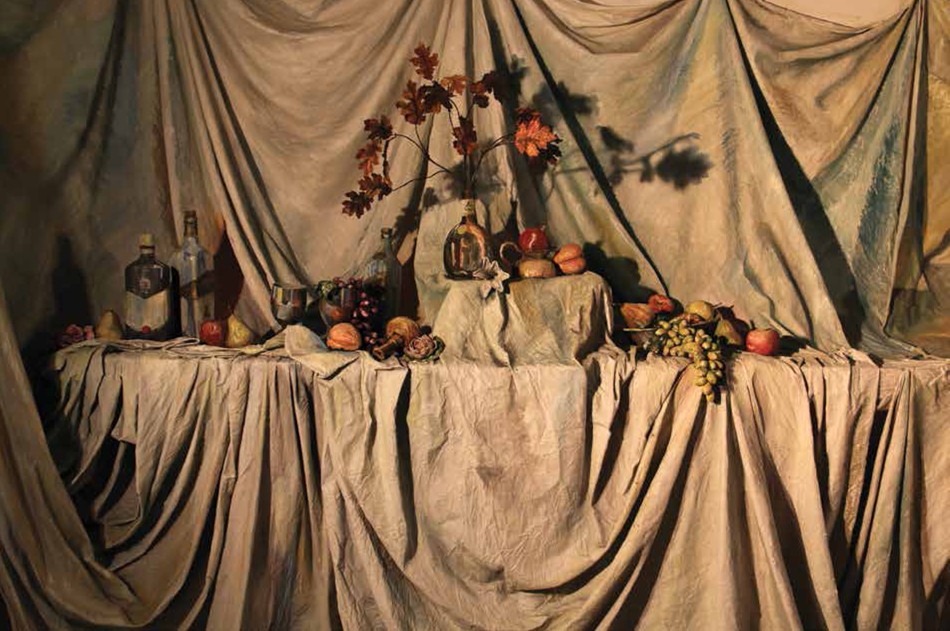
The Fine Arts Department shows some promising art work for the audience to immerse themselves at the thesis show at NCA this year

The National College of Arts thesis show has become one of the most awaited events every year. Almost everyone has it readily marked on their calendars and the college gates strain to welcome a swarm of enthusiastic art lovers, with a handful of Pindi boys of course. From word of mouth to any form of social media, the news of the opening spreads like wild fire.
The preview day brings in a throng of thirsty buyers looking for cheap loot, leaving the premises lugging their win in a hired shehzore.
The event has become so well-known that one might question whether anyone seriously considers the quality of the art work anymore. The ‘private viewing’ which ensues a day before the general public opening almost always brings good news for the hardworking thesis students -- the show sells out.
Now for an art enthusiast, the show is a real mood shifter. If the thesis is not promising enough, it leaves the concerned viewer disappointed beyond belief. But at times, like this year, it really is a pleasure walking through the nippy corridors of the aged building basking in the glorious art adorning the timeworn walls. I’d go as far to say that this year around, the students really decked their thinking hats and created particularly inventive and progressive work that reflected on the present faculty of NCA.
Muhammad Arslan Farooqi was a miniature student who had shifted from the traditional lull to give his thesis work a twist of the digital flavour. He took a number of age old Mughal miniature paintings and gusted life into them by using tools from Adobe Creative Suite. Famous paintings like "Emperor Aurangzeb in a Shaft of Light" ca. 1660 and "The Dying Inayat Khan" ca. 1618 could be viewed as a cinema graph, an interesting state-of-the-art lens provided to the viewers by Farooqi.
In another gallery, while Ahmed Javed’s large scale miniature paintings loomed over the audience, Syed Khayam Shah’s miniatures urged the spectators to stop and zoom in on the microscopic images painted out in sheer detail. Jahanzaib Akmal toiled around the idea of nostalgia where he composed paintings that incorporated the rudimentary routines of the Mughals into the eight-bit world that he spent his childhood years playing. It gave the audience a laugh to watch the kings and the noblemen on a "Bird Hunt" in the world comprising of Super Mario Brothers.
Syed Hammad Ullah Shah produced gestural art pieces which called for a courageous move in the contemporary world of miniature painting. His perspective was to merely follow the process that goes behind creating the traditional art while the end process could consist of whatsoever he desired it to be.
Furthermore, some of the painting students opted to work with installation pieces instead of working on canvases. Ahsan Ali Memon recreated hyper realistic sculptures such as coal, wood, chappatis (bread) and a brick wall by using fiberglass or canvas stretched onto frames. He commented on how the idea of dual personality struck a chord with him and how he brought that idea to life by creating objects that were not what they seemed to be.
Anam Liaqat, taking her inspiration from one of the well-known contemporary artists, Alexa Meade, put up a three-dimensional installation that purposely looked two-dimensional. Her work seemed to really awe inspire the viewers as they slowly realised that it wasn’t merely a painting, but rather a life-sized installation.
Ali Saad worked on an emotional experience that left jaded scars in his memory and he translated that pain into realistic paintings that incorporated blood and gore.
Amaani Iqbal picked up ordinary objects that hold no significance in our daily lives and are easily discarded. Though by painting them larger than life she depicted how, at times, people tend to build diverse belief systems around objects such as a clump of hair or the date seed.
Ali Akbar put up installations using computer desktops operating on a loop playing out everyday usage of these electronic devices. According to him, everyone’s personal computer showcases their personality, how every desktop is filled with folders or images that we put up so our first impression comes off as well-mannered one but the deeper we go into them the more intimate we become with others by letting them in on our deepest darkest secrets.
Another painting student, Sadqain worked on installations where he played on the deception of a first look. He created different pieces that played on the idea of how one’s first impression is confined to the outer layer of the concerned object but the deeper one borrows they find aspects that take them beyond their personal space and show glimpses of their true selves.
Being the only print making student, Sahibzada Sangeen Noor took his inspiration from Japanese Manga. His work represented his personal perception of the world and revolved around some of his life experiences as a Pakistani. He showed a constant self-peering into experiences where teachers seemed to transform into monsters, guests at a wedding into gluttonous pigs and addicted peers were depicted as babies hooked onto milk.
Whereas Sohail Tahir, a sculpture student, used scrap metal to build a larger than life depiction of folklore that he grew up listening to. Moreover, to name just a few of the students who had their thesis work on display, it was an absolute pleasure to be able to visit NCA as an alumna and to see promising art work come to life for the audience to immerse themselves in.